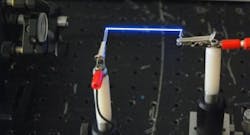| A femtosecond laser creates a thin column of plasma in the air between two electrodes. (Photo by Pavel Polynkin) |
Earlier this year, researchers at the University of Arizona (UA; Tucson, AZ) and the University of Central Florida (UCF; Orlando, FL) created a dual-femtosecond-laser-beam setup that channels plasma filaments and could divert lightning strikes; now, the UA team, along with a researcher at Phillipps-Universität Marburg (Marburg, Germany), have augmented such a setup with a laser producing much longer (nanosecond-range) pulses that continue to heat the plasma, reducing the breakdown of the electrical field by up to a factor of four.1
The nanosecond laser replaces one of the femotsecond lasers in the earlier setup. As in the previous research, the new technique can potentially direct an electrical discharge up to 10 m away or more. One potential use is the remote detonation of land mines.
Superheating required
The researcher were aided by understanding how the atmosphere behaves when it was subjected to these extremely energetic light pulses (the femtosecond "igniter" pulse and the nanosecond "heater" pulse). They recognized that it wasn't the actual plasma created by the lasers that made the atmosphere more conductive; it was the subsequent superheating that lowered the density of the filament of air. Without some additional input of energy, however, this zone of lower density quickly collapsed. To improve both distance and duration, a second energy source was needed to rapidly reheat the air, stabilizing the filament just long enough to carry an electrical current.
Based on their initial results, the researchers believe that other forms of heater beams, such as microwaves or long-wavelength lasers, could further increase the distances they were able to achieve, though other issues would need to be addressed before applications like channeling lightning could be achieved.
As a next step, the researchers are planning on using a microwave beam in place of the nanosecond laser to more efficiently heat the channel and perhaps achieve better results.
Source: http://uanews.org/story/laser-lightning-rods-channel-electricity-through-thin-air
REFERENCE:
1. Maik Scheller et al., Optica (2014); http://dx.doi.org/10.1364/OPTICA.1.000125
